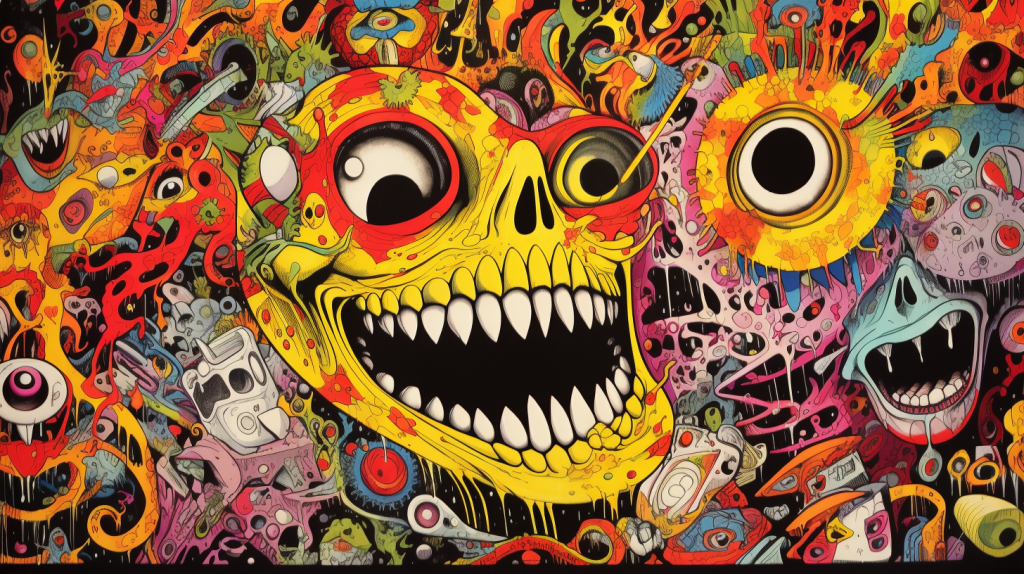What My First Music Festival Taught Me About Substance Abuse In America.
In June, I attended Electric Forest, a several-days-long marathon of electronic music in northwest Michigan. While I’d attach some caveats and footnotes to my next statement, I had an absolute blast, and returned with a number of ideas about the event. Don’t worry, there is going to be a separate article about what urban planning brain saw there– but this article, rather, is about the Party Scene And Her Drugs.
Partying In The Age of Drug Legalization
I’ve noticed a substantial shift over the past several years as cannabis has become recreationally legalized (and even destigmatized) in many places. In Michigan, cannabis is ubiquitous– truly, pot shops on every corner- and, from a market competition standpoint, it’s gotten to the point that companies are all but begging customers to take product off their hands. One local dispensary advertised 15 grams worth of vapes for $100, which is enough to get a professional pothead high for months on end. The economics of it all are truly astounding. Federal statistics (from the DEA and others) similarly show that the average price of an ounce of cannabis had dropped precipitously approximately during the decade 2010-2020, concomitant with the rise of recreational weed.

First: People Seem To Be Driven More By FOMO Than By The Prospects of Substance Abuse
At least in my personal experience, young people who party til they drop, literally or figuratively, seem to be driven by FOMO rather than by the prospects of being able to get free cocaine. I was offered cocaine multiple times, but always in a passing way, as, “hey, man, you wanna do a bump?” rather than the stereotypes I’ve often had of the powderati– a grunting, red-faced man, excitedly proclaiming, “hey, man, we are going to do some fuckin’ COCAINE!”
We ran into those types, too, of course. But it was the consensus of our particular group that these folks were bringing down the vibe, and were therefore not to be associated with. I was apprehensive about this, because I tend to get along much better with the psychedelic crowd than with the heavy-drinking, coke-snorting crowd. They are much gentler, much more empathetic, and their variety of partying is more about communal experience than it is about going as hard as humany possible.
Generally I feel this same way about cocaine users as I do about colleagues who drink extraordinarily heavily at social or even professional events. Alcohol is a drug that reduces inhibitions in ways that can be fun, but it also has the side effect of creating behavior that is destructive to the self, destructive to others, and potentially destructive to property, whether we’re talking about drunk drivers crashing cars or people bumping into objects because they’re too intoxicated. For the most part, this does not happen with the psychedelics or cannabis that seem to dominate the festival scene.
Second: The Number Of Non-Drinkers-But-Drug-Doers Has Exploded In Recent Years. And That’s Probably Mostly Fine.
An article in Scientific American suggests a huge rise in the use of LSD over the past decade or so, looking at a nearly doubling rate of LSD use in the EDM scene in one city over just a few years, for example. The article points out that the total percentage of people who reported having done LSD, though, is lower than it was in the 1960s and 1970s (though I think it’s probably also worth noting that the US is far more diverse and about 150% of the population that it was in that era).
Citing one popular news article here:
“Significant research shows that the substance is not physically addictive, however, and that LSD overdoses are generally not considered life-threatening and subside within 72 hours. In some cases, people who accidentally overdose on the drug have even reported long-term improvements, according to a study published in the Journal of Studies on Alcohol and Drugs. In 2015, for example, a 49-year old woman reportedly took 550 times the normal recreational dose of LSD because she mistook it for a line of cocaine. According to CNN, after being incapacitated for about a day, the woman said that chronic pain she had suffered in her feet and ankles, caused by Lyme disease, had significantly improved. “It just shows that LSD is not that harmful drug that everyone makes it out to be,” Yockey says.”
The article concludes with the observation from an expert that methamphetamine, cocaine, heroin, and fentanyl are, for regulatory and legal purposes, grouped into the same category as drugs like LSD and psilocybin, even though these drugs have, according to a number of studies, demonstrated clinical benefit. Most people I know who recreationally indulge in psychedelics refuse to ever touch drugs like cocaine or opioids, and, certainly, this split has become more intense in recent years with the sky-high rates of overdose deaths.
Third: Drinkers On Average Seem Way More Destructive Than Most Drug Users.
Most of the reason why I transferred from my first school was because of the heavy emphasis on Greek life, which, for something like eight of the nine approved fraternities, mostly centered around getting completely obliterated at least a couple of times a week. As someone who used to rather enjoy drinking a lot more than I do now, this was still repulsive to me, because drinking for me was not a matter of derailing my mind, but rather a novelty that allowed a combination of relaxation with something that hopefully tasted good.
This is why, in college, I started drinking Boulevard Beer rather than, say, Natty Lite, even if it meant drinking less of it as a matter of economics. I noticed a lot of the destructive power of alcohol in both colleges I went to– the college I transferred to, Grinnell in Iowa, also had an absolutely wild drinking culture, but at least it wasn’t just frat houses, it was more like themed events that were fun whether or not you were drinking.
Now, as I hurtle headlong toward middle age, I’m thinking about the number of people I’m personally friends with whom I’ve seen drinking way less than they used to. This is part of a broader societal trend, in which a surprisingly number of especially younger people just don’t drink at all. Watching the behavior of folks, it’s fairly easy to see why. Drunk people fall over. They break things. They hit each other. They trash spaces. I noted that in our corner of our campsite– in which the average rate of alcohol consumption per person probably worked out to 1-4 drinks per day over a 16-hour day (and often didn’t involve drinking in the festival as a matter of cost). We didn’t make messes, nor did we knock stuff over. Again, contrast with the cokebros wit whom we shared part of a campsite. The objective for these folks was emphatically, it seemed, to break stuff and fall over.
The aftermath of any party is also cleaner and more functional. It is fairly easy to come back to your campsite while coming down off a drug trip and still have the coherency to pick up some trash, or even cook a late-night meal. Not so much when you’re drunk. Drunk people make messes, vomit on things, and have horrific mornings-after. There is, in contrast, no hangover from mushrooms or LSD. MDMA, in comparison, is one drug that I find a bit more terrifying, because it does have the potential to fuck up your shit in a way that other psychedelics frankly do not.
Fourth: Drug Safety Is Key. And Most Drug Users Know This.
Most people who require medical attention at these festivals seem to be suffering from heat exhaustion rather than drug overdoses. The body has a limited ability to cool itself off, between sweaty bodies dancing and the formidable Michigan sun (temperatures peaked at 87 and 85 or so, and were then cooler– while most of the festival’s major activity is in the later afternoon into the late night). This is further complicated by the fact that some psychedelic drugs tend to alter your body’s temperature, thereby increasing the risk of heat exhaustion.
Security incidents are rare, but do happen. I did not see a single fight, unless you count me having witnessed not one, but at least three couples arguing over where someone put the weed. (“Babe! I thought I gave it to you!”) This is at least an increasingly rare conflict in Michigan, where, as mentioned, cannabis is so cheap it’s basically free to get high.
But the biggest issue I want to mention about drug safety was one that I saw frequently discussed, and this is one of the use of drug test kits– something referenced heavily in Ben Westhoff’s excellent book about fentanyl. These kits are relatively affordable, and allow you to ensure that the drug you think you’re taking is, in fact, the one you’re actually taking. Utilizing destructive testing and a series of reagents (a droplet of the latter combined with a small sample of the drug), they are relatively foolproof, and the fanciest ones include not one, but three tests that you can do per drug. The combined solution corresponds to a color on a printed chart– for example, “this drug, when mixed with Reagent A, is meant to turn a bright pink color! If it turns brown instead, it’s probably contaminated with fentanyl!” Fentanyl is the typical lethal contaminant of drugs, but contamination is, per the anecdotal evidence I’ve received from psychonauts, fairly rare in comparison to drugs like cocaine. Recall that drug overdoses (presumably from fentanyl-contaminated cocaine) taking place the same month as Electric Forest killed three employees of a Grosse Pointe pizzeria.
For legal reasons (love lawyers!), Electric Forest doesn’t provide test kits, nor do they allow booths to be set up with test kits, but they are fairly easy to come by. I was encouraged to see that the kids, in fact, may well be all right.
The Handbuilt City doesn’t endorse the use of illegal drugs, whether or not they should be legal. Drug use should always be in a controlled setting and it is the personal belief of the author that everyone getting anywhere near psychedelics specifically should probably 1) go through some sort of psychological evaluation beforehand, 2) should be aware of their own cardiovascular health, and 3) should spend several hours reading up on the pharmacology and social context of these substances.


